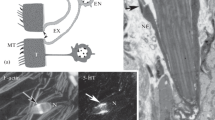Summary
The integuments of the priapulids Halicryptus spinulosus and Priapulus caudatus exhibit a similar ultrastructure. The epithelial cells, the neighbouring lateral plasma membranes of which are frequently highly interdigitated, are connected by long septate desmosomes and are apically covered by an amorphous cuticle. The latter shows a stratification, the pattern of which is dependent on the moulting phase. Similar cuticular structures are to be found in nematodes. The cuticle of the larvae of Halicryptus differs markedly from that of the adult animals and also does not show agreements with the armour of kinorhynchs. It is threelaminated and contains in the middle layer canalicular structures. The epithelial spines of Halicryptus spinulosus contain various types of secretory cells. The epithelial differentiations at the end of the body of Priapulus caudatus also represent, according to their ultrastructure, secretory cells. The fine structure of the appendicular organs of Priapulus caudatus corresponds to that of cells engaged in ion transport. In addition this organ possesses mechanoreceptors. Both priapulids carry, on the integumental papillae and within the epithelium of the body and pharynx, characteristically constructed receptors with an apical cilium surrounded by seven microvilli. They are interpreted to represent mechanoreceptors.
Zusammentassung
Die Integumente der Priapuliden Halicryptus spinulosus und Priapulus caudatus sind ähnlich aufgebaut. Die miteinander verzahnten und über lange septierte Desmosomen verbundenen Epithelzellen tragen apikal eine amorphe, in Abhgngigkeit von der Häutungsphase± geschichtete Kutikula. Ähnliche Kutikulastrukturen finden sich bei Nematoden. Der Panzer der Halicryptus-Larve ist in seiner Ultrastruktur deutlich verschieden von der Kutikula adulter Tiere and zeigt auch keine Übereinstimmung mit dem Panzer der Kinorhynchen.
Die epithelialen Stacheln der Art Halicryptus spinulosus enthalten mehrere Sekretzelltypen. Die epithelialen Differenzierungen am Rumpfende von Priapulus caudatus sind durch ihre Ultrastruktur ebenfalls als sezernierende Zellkomplexe gekennzeichnet.
Der Feinbau des distalen Anhangsorganes von Priapulus caudatus entspricht der Ultrastruktur von Zellen mit aktivem Ionentransport. AuBerdem ist dieses Organ Träger von Mechanorezeptoren.
Similar content being viewed by others
Literatur
Adam, H., Czihak, G.: Arbeitsmethoden der makroskopischen und mikroskopischen Anatomic. Stuttgart: Fischer 1964.
Apel, W.: Beitrag zur Anatomic und Histologie des Priapulus caudatus (Lam.) und des Halicryptus spinulosus (v. Siebold). Z. wiss. Zool. 42, 459–529 (1885).
Bouligand, Y.: Les soies et les cellules associées chez deux Annélides Polychètes. Z. Zellforsch. 79, 332–363 (1967).
Burn, J. H.: The autonomic nervous system, 3rd ed., 149 pp. Oxford and Edinburgh: Blackwell Scientific Publications 1968.
Carlisle, D. B.: On the exuvia of Priapulus caudatus Lamarck. Ark. 12, 79–81 (1961).
Copeland, E.: A mitochondrial pump in the cells of anal papillae of mosquito larvae. J. Cell Biol. 23, 253–263 (1964).
Eakin, R. M.: Evolution of photoreceptors. Cold Spr. Harb. Symp. quant. Biol. 30, 363–370 (1965).
Fänge, R.: Priapuloidea. In: Florkin: Chemical zoology, vol. 3. New York: Acad. Press 1968.
Fänge, R., Matisson, A.: Function of the caudal appendage of Priapulus caudatus. Nature (Lond.) 190, 1216–1217 (1961).
Florey, E.: Lehrbuch der Tierphysiologie, 574 S. Stuttgart: Thieme 1970.
Graziadei, P. P. C., Tucker, D.: Vomeronasal receptors in turtles. Z. Zellforsch. 105, 498–514 (1970).
Hammersten, O.: Zur Entwicklungsgeschichte von Halicryptus spinulosus (v. Siebold). Z. wiss. Zool. 112, 527–571 (1915).
Hammond, R. A.: The surface of Priapulus caudatus (Lamarek). Z. Morph. Tiere 68, 255–268 (1970).
Komnick, H., Komnick, U.: Elektronenmikroskopische Untersuchungen zur funktionellen Morphologie des Ionentransportes in der Salzdrüse von Larus argentatus.. V. Experimenteller Nachweis der Transportwege. Z. Zellforsch. 60, 163–203 (1963).
Land, J. van der: A new aschelminth, probably related to the priapulida. Zoologische Meded. 42, 237–250 (1968).
Land, J. van der: Systematics, zoogeography and ecology of the Priapulida. Zoologische Verhandelingen 112, 1–118 (1970).
Lang, K.: Contribution to the ecology of Priapulus caudatus Lam. Ark. Zool. 41 A5, 1–12 (1949).
Lang, K.: Die Entwicklung des Eies von Priapulus caudatus Lam. und die systematische Stellung der Priapuliden. Ark. Zool. 5, 321–348 (1953).
Lang, K.: The relation between the Kinorhyncha and Priapulida and their connection with the Aschelminthes. In: Dougherty, E. C., et al. (eds.), The lower Metazoa, comparative biology and phylogeny, p. 256–262 (1963).
Laverack, M. S.: On superficial receptors. Symp. Zool. Sec. Lond. 23, 299–326 (1968).
Moritz, K., Storch, V.: Über den Aufbau des Integumentes der Priapuliden und der Sipunculiden. Z. Zellforsch. 105, 55–64 (1970).
Moritz, K., Storch, V.: Elektronenmikroskopische Untersuchung eines Mechanorezeptors von Evertebraten (Priapuliden, Oligochaeten). Z. Zellforsch. 117, 226–234 (1971).
Moritz, K., Storch, R.: Zur Feinstruktur des Integumentes von Trachydemus giganteus Zelinka (Kinorhyncha). Z. Morph. Tiere 71, 189–202 (1972).
Nyholm, K.-G., Bornö, C.: Introductory studies of the oxygen intake of Priapulus caudatus Lam. Zool. Bidr. 38, 262–264 (1969).
Richardson, K. C., Jarret, L., Finke, E.: Embedding in Epoxyresins for ultrathin sectioning on electron microscopy. Stain Technol. 35, 313–323 (1960).
Shapeero, W. L.: Phylogeny of Priapulida. Science 133, 879–880 (1961).
Storch, V., Welsch, U.: Über den Aufbau des Rotatorienintegumentes. Z. Zellforsch. 95, 405–414 (1969).
Storch, V., Welsch, U.: Über den Aufbau resorbierender Epithelien darmloser Endoparasiten. Zool. Anz., Suppl. 33, 617–621 (1969).
Vinnikov, J. A.: Principles of structural, chemical, and functional organization of sensory receptors. Cold Spr. Harb. Symp. quant. Biol. 20, 293–299 (1965).
Watson, B. D.: The fine structure of the bodywall and the growth of the cuticule in the adult nematode Ascaris Lumbricoides. Quart. J. micr. Sci. 106, 83–91 (1965).
Wessing, A.: Funktionsmorphologie von Exkretionsorganen bei Insekten. Zool. Anz., Suppl. 31, 633–681 (1968).
Author information
Authors and Affiliations
Additional information
Für die Überlassung eines Arbeitsplatzes im Institut far Pharmakognosie Kiel danke ich Herrn Prof. Dr. D. Frohne. Alit dankenswerter Unterstützung durch die Deutsche Forschungsgemeinschaft.
Rights and permissions
About this article
Cite this article
Moritz, K. Zur feinstruktur integumentaler bildungen bei priapuliden (Halicryptus spinulosus und Priapulus caudatus). Z. Morph. Tiere 72, 203–230 (1972). https://doi.org/10.1007/BF00391552
Received:
Issue Date:
DOI: https://doi.org/10.1007/BF00391552




